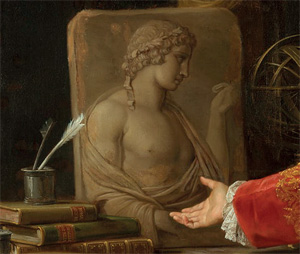SNF-Projekt «Gedächtnistransfers in Kunst und Wissenschaft, 1650-1800»
«Memory Transfers in Art and Science, 1650-1800»
Leitung: Prof. Dr. Bettina Gockel
Habilitation Project: Dr. Miriam Volmert
The project „Memory Transfers in Art and Science, 1650-1800“ aims at discussing historical concepts of memory and remembering with a focus on seventeenth- and eighteenth-century art, art theory, and science.
Recent studies have increasingly devoted attention to early-modern psychophysical concepts, metaphors, and theories of memory as well as the history of storage systems and information management. Ann Blair’s study Too Much To Know: Managing Scholarly Information before the Modern Age (Yale University Press, 2010) explores the historical concepts of information overload by analyzing practices and theories of early-modern information management. Jeremy Black’s most recent book The Power of Knowledge. How Information and Technology Made the Modern World (Yale University Press, 2014) has discussed the impact of social practices of managing information on the formation and self-understanding of modern societies. As various studies have demonstrated, research on historical memory discourses may contribute to a clearer understanding of the present paradigmatic shifts in dealing with knowledge as a result of new cloud-computing systems of storing memories.
Our project takes up historical perspectives on memory and remembering from an art historical point of view. It explores pictorial and artistic aspects of late seventeenth- and eighteenth-century memory systems and related problems of dealing with information and knowledge. The project aims to analyze the various ways in which the “anthropological” long eighteenth century was interested in understanding psychological and physiological processes of learning and memorizing in the light of scientific association theories and within the broader context of new paradigms of systematization.
In suggesting that a fundamental shift in traditional concepts of human memory in relation to changing information management systems took place in the long eighteenth century, focus will be placed upon questions of how changing theories of remembering and forgetting were reflected within new artistic topics and media as well as in art theoretical discourses. The project is particularly interested in the interrelationship of the history of memory and the culture of seeing; in the mediality and materiality of remembering in the arts; in historical ways of dealing with large quantities of information and their pictorial and artistic reflections; in the role of the portrait genre, particularly in its relation to new forms of souvenir objects in the late eighteenth century.
Sub-Project «Memory in Motion. Concepts of Remembering in 18th-Century Grand Tour Portraits»
Dr. Miriam Volmert
This post-doc research project examines eighteenth-century portraits of British Grand Tour travellers, focusing on historical concepts of memory and remembrance and their relation to issues of learning and experiencing on the Grand Tour. It explores the pictorial modes of displaying travel souvenirs, personal memory, and reminiscence of antiquity by taking into account both eighteenth-century psychophysical memory theories and the cultural role and development of external memory storage systems. Central to this topic will be questions of how changing theories of remembering and forgetting, which can be related to the gradual abandonment of traditional rhetorical discourses in favour of new scientific and psychological paradigms around the early eighteenth century, were reflected within the cultural context of the Grand Tour.
Considering Grand Tour portraits a focal point of related dimensions of remembering and experiencing memories, the research centres on paintings by the portrait painters Pompeo Batoni, David Allan, and Hugh Douglas Hamilton, and also includes discussions of related portrait genres such as miniature paintings and portrait busts and travel souvenirs such as fans and micromosaics. Among the written primary sources, certain genres of travel literature, such as diaries, commonplace books, and travel vade-mecums, are of particular interest, in addition to art-theoretical treatises and psychophysical and philosophical essays on human memory.
Within the broad research field of the eighteenth-century British Grand Tour, recent studies have taken a growing interest in aspects of mobility and cultural dynamism by focusing on international trading and collection processes; this perspective may also have fostered the growing interest in exploring the Grand Tour as a hub of complex and ambivalent sense perceptions. The present project will pursue this approach by addressing aspects of experiencing, seeing, and learning with regard to shifting paradigms of cultural memory systems.
